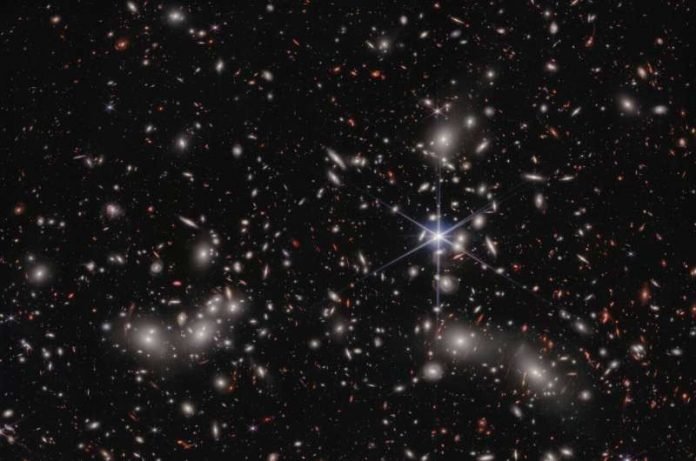
Using the James Webb Space Telescope’s advanced capabilities, scientists have made groundbreaking observations of the universe’s earliest galaxies, shedding light on a critical period known as the era of reionization.
This era, occurring within the first billion years of the universe’s existence, was a pivotal time when the cosmos transitioned from darkness, filled with a dense hydrogen fog, to a universe illuminated by the first stars and galaxies.
The key players in this dramatic transformation have long been a mystery to astronomers, but the recent findings, published in Nature, suggest that small, dwarf galaxies played a significant role in this cosmic evolution.
The study focused on the Ultradeep NIRSpec and NIRCam Observations before the Epoch of Reionization (UNCOVER) program, which leveraged gravitational lensing by the galaxy cluster Abell 2744, also known as Pandora’s Cluster.
Gravitational lensing occurs when a massive cluster of galaxies distorts the space around it, magnifying and bending the light from more distant galaxies behind it.
This phenomenon allowed the researchers to detect and study eight extremely faint galaxies that would otherwise remain invisible, even to the powerful James Webb Space Telescope.
These distant galaxies were found to be prodigious sources of ionizing radiation, emitting levels of energy previously unanticipated.
The study revealed that these galaxies produce ionizing photons at a rate four times greater than previously thought, suggesting that they were primarily responsible for the reionization of the universe.
This ionizing radiation transformed the early universe’s dense hydrogen fog into an ionized plasma, allowing light to travel freely through space.
The discovery underscores the importance of ultra-faint galaxies in the early universe, revealing that despite their small size, these galaxies were capable of producing enough energetic radiation to alter the state of the universe significantly.
This challenges previous assumptions and highlights the need for a deeper understanding of low-mass galaxies in the cosmic narrative.
The researchers employed a combination of ultra-deep imaging data from the James Webb Space Telescope and additional imaging from the Hubble Space Telescope to identify these galaxy candidates.
They then used Webb’s Near-InfraRed Spectrograph (NIRSpec) for spectroscopic analysis, which provided a detailed look at the galaxies’ properties and confirmed their significant role during the epoch of reionization.
This study marks the first time scientists have been able to measure both the number density of these faint galaxies and their ionizing power, confirming their abundance and crucial role during this period.
The findings not only offer new insights into the reionization era but also demonstrate the unparalleled observational capabilities of the James Webb Space Telescope.
Looking ahead, the GLIMPSE observing program aims to obtain even deeper observations of another galaxy cluster, Abell S1063, to identify fainter galaxies and further explore the distribution of galaxies during the epoch of reionization.
These observations will also assist in studying the period known as Cosmic Dawn, offering a more comprehensive understanding of the first galaxies’ emergence and the early universe’s evolution.
The research findings can be found in Nature.
Copyright © 2024 Knowridge Science Report. All rights reserved.



